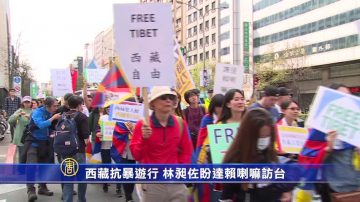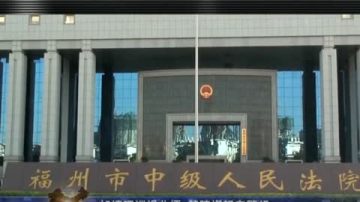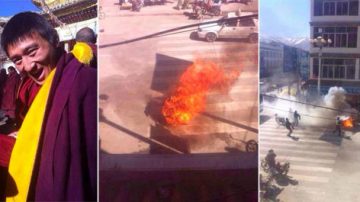【新唐人2011年12月1日讯】今年以来,中国藏区频频发生僧尼和佛教徒自焚事件。学者认为,中共消灭宗教的政策从来没有改变,导致冲突不断。而中共与阿坝地区藏人的冲突由来已久,涉及三代人。中共的所谓“反分裂”政策,对僧人的严格限制也是导致民族抗争不断的主要原因之一。
四川阿坝地区甘丹曲林寺的35岁藏族尼姑班丹曲措,为抗议中共当局对藏区的严厉管制,11月3号自焚死亡,她是自今年3月16号,阿坝格尔登寺20岁僧人平措自焚之后,第11个自焚的佛教徒,也是死亡的第6人。
旅美西藏近代史学者李江琳通过研究发现,阿坝地区藏人与中共的冲突由来已久,涉及三代人。而僧人以死抗争是因为阿坝州对僧人的限制极其严苛。
以发生首例僧人自焚事件的格尔登寺为例,中共当局强制格尔登寺必须遵守的条例就有356条之多,这还不包括相关法规和各县的“土政策”和许多不公开的“红头文件”,另外,还设有群众监督评议委员会、寺管会等,僧人的一举一动都在层层监督之下。
出家的僧人不但无法学经,还要被迫接受“爱国主义教育”、诋毁他们的上师,他们内心非常痛苦和愤怒。
李江琳从红军将领们的回忆录中发现,藏人与红军进行了很多次战斗,所以第一代仇恨从那时就开始了。
李江琳:“第一代是红军时期,红军路过川西北地方,长征时间的三分之二是在四川就是在藏区度过的,其中主要是在阿坝和嘉绒地区。他们大量抢夺藏民的粮食,而且他们住在格尔登寺的大殿里,在它们的壁画上写标语。”
阿坝藏族自治州是四川省的第二大藏区,格尔登寺是当地规模最大的藏传佛教寺院,西元1412年创建。而中共篡政后,格尔登寺一度被摧毁。中共的战争造就了第二代仇恨。
李江琳:“56年到62年,在那一代发生了战争。特别是后来1958年的‘四反运动’,寺院几乎全部关闭,绝大多数关闭。格尔登寺从1958年逐渐的被摧毁,到了文革期间,除了两三间房子以外变成了一座荒地,完全没有了。”
那时青海、四川、西藏所有的寺院,包括汉区也都一样,寺院被大量的摧毁。现在的格尔登寺是80年代胡耀邦执政期间重建的。
民族干部杨岭多吉从1980到1985年在西藏担任自治区领导。他认为,胡耀邦、赵紫阳主政时代是实现民族和解的最好时期,那段时间关系缓和,藏区也比较平静,但89年之后民族政策大逆转,矛盾日渐激化。
对于近期藏人连续以自焚抗争,有西藏学者认为,这是中共的新殖民主义、种族灭绝政策导致的。李江琳认为,连续的自焚、绝不是谁能指使的。应该让国际媒体做独立调查,让当地藏人说话。
不过,中共声称,在中国,宗教是自由的。
对此,李江琳表示,中共从50年代一直到现在,从未隐瞒最终消灭宗教的主张,也不讳言“宗教自由”只是一个策略。她质疑:在执政党以促进宗教消亡为指导思想的国家里,能允许宗教自由存在吗?
新唐人记者周玉林、宋风、孙宁采访报导。
When Will Tibetan Self-Immolations End?
This year, China has witnessed a rash of self-immolations
of Tibetan Buddhist monks and nuns.
Scholars say that the Chinese Communists Party (CCP)
has never changed its policy towards religions, which has fueled one conflict after another.
The conflict between the CCP and Aba-based Tibetans
has a long history.
The CCP's so-called "anti-secession" policy,
which has put severe restrictions on Tibetan Monks, is one of the main reasons behind these endless protests.
Palden Choetso, a 35-year-old Tibetan nun, self-immolated
on November 3 in Aba Prefecture, Sichuan Province,
China to protest the CCP's strict control over
the Tibetan region.
Palden was the 11th. self-immolation and the sixth death
since 20 year-old monk, Phuntsog's self-immolation related death this March.
According to a study conducted by Li Jianglin,
a U.S.-based scholar on Tibetan modern history,
Aba-based Tibetans have been fighting against the CCP
for three generations.
The Monks' idea of defending their country to the death is
due to the extremely harsh restrictions placed on the Monks there, by the CCP Aba authorities.
For example, the first monk to self-immolate resided in the
Geer Deng Monastery,
which is harshly governed by 356 mandatory regulations
stipulated by the CCP authorities.
Besides that, there are relevant laws, regulations,
and local policies of various counties and lots of secret official documents to abide by and follow.
The authorities also set up the Mass Supervision and
Appraisal Committee, the Temple Management Committee,
and other agencies,
to put local Buddhists under constant surveillance.
Monks and nuns are not only prevented from studying scriptures,
but are also forced to and to slander their guru and accept the CCP’s official "patriotic education."
which causes them a lot of pain and makes them furious.
Li Jianglin found that the Red Army generals' memoirs
mentioned many wars between the Tibetans and the Red Army.
It was at that time that the seeds of hatred were sown in the
hearts of the first generation of Tibetans.
Li Jianglin: "The first generation of hatred took place
during the Red Army era, when the Red Army passed through the northwestern part of Sichuan Province.
Two-thirds of the Long March was spent in the Tibetan areas
of Sichuan Province, mainly at Aba and Gyalrong regions.
The troops stole large amounts of food from the Tibetans.
When the CCP troops occupied the Geer Deng Temple Hall,
they even wrote CCP slogans on the murals."
The Aba Tibetan Autonomous Prefecture is the second largest
Tibetan-inhabited area in Sichuan Province.
The Geer Deng Temple is the largest local Tibetan Buddhist
temple, founded in 1412 AD.
The Geer Deng Temple was destroyed after the
CCP came to power.
The CCP‘s internal wars generated a second generation of hatred.
Li Jianglin: "From 1956 to 1962, a war took place in that area,
especially after the CCP's Four-Anti Movements were initiated in 1958,
which saw the closure of almost every monastery.
Since 1958, the Geer Deng Temple was gradually destroyed.
During the Cultural Revolution, there were only two or
three houses left standing and the surrounding area looked like a wasteland."
At that time, all the monasteries in Qinghai and Sichuan
Province and Tibet, as well as in other regions of China, were destroyed.
The current Geer Deng Temple was reconstructed
during the reign of Hu Yaobang, in the 1980s.
Yang Ling Dorje, a former senior Tibetan cadre said that
the period between 1980-1985, which was during
the reign of Hu Yaobang and Zhao Ziyang, was the best period,
which helped foster national reconciliation.
At that time, relationships between the different nationalities
eased, and the Tibetan-inhabited areas were relatively calm.
However, after 1989, the nationality policy went into reverse,
and conflicts among the different nationalities dramatically increased and intensified.
Tibetan scholars often comment on the ongoing Tibetan
self-immolations, saying that
that was due to the CCP's implementation of
its new colonialism and genocide policy.
Li Jianglin believes that the ongoing self-immolation incidents
are absolutely unable to be pointed by anyone.
She proposes that the international media should conduct
independent investigations, helping local Tibetans to speak out.
However, the CCP authorities have the insane audacity
to claim that China enjoys freedom of religion.
In response to the CCP's claim, Li Jianglin said that
since the 1950s the CCP authorities have never tried to conceal
their intention of ultimately eliminating religions,
nor did they avoid mentioning the term "religious freedom,"
which was just a propaganda tactic.
Jianglin asks the question: if the ruling party of a country
is dead set on eliminating religions as its guiding ideology, how can religious freedom really exist?
NTD reporters Zhou Yulin, Song Feng and Sun Ning.
四川阿坝地区甘丹曲林寺的35岁藏族尼姑班丹曲措,为抗议中共当局对藏区的严厉管制,11月3号自焚死亡,她是自今年3月16号,阿坝格尔登寺20岁僧人平措自焚之后,第11个自焚的佛教徒,也是死亡的第6人。
旅美西藏近代史学者李江琳通过研究发现,阿坝地区藏人与中共的冲突由来已久,涉及三代人。而僧人以死抗争是因为阿坝州对僧人的限制极其严苛。
以发生首例僧人自焚事件的格尔登寺为例,中共当局强制格尔登寺必须遵守的条例就有356条之多,这还不包括相关法规和各县的“土政策”和许多不公开的“红头文件”,另外,还设有群众监督评议委员会、寺管会等,僧人的一举一动都在层层监督之下。
出家的僧人不但无法学经,还要被迫接受“爱国主义教育”、诋毁他们的上师,他们内心非常痛苦和愤怒。
李江琳从红军将领们的回忆录中发现,藏人与红军进行了很多次战斗,所以第一代仇恨从那时就开始了。
李江琳:“第一代是红军时期,红军路过川西北地方,长征时间的三分之二是在四川就是在藏区度过的,其中主要是在阿坝和嘉绒地区。他们大量抢夺藏民的粮食,而且他们住在格尔登寺的大殿里,在它们的壁画上写标语。”
阿坝藏族自治州是四川省的第二大藏区,格尔登寺是当地规模最大的藏传佛教寺院,西元1412年创建。而中共篡政后,格尔登寺一度被摧毁。中共的战争造就了第二代仇恨。
李江琳:“56年到62年,在那一代发生了战争。特别是后来1958年的‘四反运动’,寺院几乎全部关闭,绝大多数关闭。格尔登寺从1958年逐渐的被摧毁,到了文革期间,除了两三间房子以外变成了一座荒地,完全没有了。”
那时青海、四川、西藏所有的寺院,包括汉区也都一样,寺院被大量的摧毁。现在的格尔登寺是80年代胡耀邦执政期间重建的。
民族干部杨岭多吉从1980到1985年在西藏担任自治区领导。他认为,胡耀邦、赵紫阳主政时代是实现民族和解的最好时期,那段时间关系缓和,藏区也比较平静,但89年之后民族政策大逆转,矛盾日渐激化。
对于近期藏人连续以自焚抗争,有西藏学者认为,这是中共的新殖民主义、种族灭绝政策导致的。李江琳认为,连续的自焚、绝不是谁能指使的。应该让国际媒体做独立调查,让当地藏人说话。
不过,中共声称,在中国,宗教是自由的。
对此,李江琳表示,中共从50年代一直到现在,从未隐瞒最终消灭宗教的主张,也不讳言“宗教自由”只是一个策略。她质疑:在执政党以促进宗教消亡为指导思想的国家里,能允许宗教自由存在吗?
新唐人记者周玉林、宋风、孙宁采访报导。
When Will Tibetan Self-Immolations End?
This year, China has witnessed a rash of self-immolations
of Tibetan Buddhist monks and nuns.
Scholars say that the Chinese Communists Party (CCP)
has never changed its policy towards religions, which has fueled one conflict after another.
The conflict between the CCP and Aba-based Tibetans
has a long history.
The CCP's so-called "anti-secession" policy,
which has put severe restrictions on Tibetan Monks, is one of the main reasons behind these endless protests.
Palden Choetso, a 35-year-old Tibetan nun, self-immolated
on November 3 in Aba Prefecture, Sichuan Province,
China to protest the CCP's strict control over
the Tibetan region.
Palden was the 11th. self-immolation and the sixth death
since 20 year-old monk, Phuntsog's self-immolation related death this March.
According to a study conducted by Li Jianglin,
a U.S.-based scholar on Tibetan modern history,
Aba-based Tibetans have been fighting against the CCP
for three generations.
The Monks' idea of defending their country to the death is
due to the extremely harsh restrictions placed on the Monks there, by the CCP Aba authorities.
For example, the first monk to self-immolate resided in the
Geer Deng Monastery,
which is harshly governed by 356 mandatory regulations
stipulated by the CCP authorities.
Besides that, there are relevant laws, regulations,
and local policies of various counties and lots of secret official documents to abide by and follow.
The authorities also set up the Mass Supervision and
Appraisal Committee, the Temple Management Committee,
and other agencies,
to put local Buddhists under constant surveillance.
Monks and nuns are not only prevented from studying scriptures,
but are also forced to and to slander their guru and accept the CCP’s official "patriotic education."
which causes them a lot of pain and makes them furious.
Li Jianglin found that the Red Army generals' memoirs
mentioned many wars between the Tibetans and the Red Army.
It was at that time that the seeds of hatred were sown in the
hearts of the first generation of Tibetans.
Li Jianglin: "The first generation of hatred took place
during the Red Army era, when the Red Army passed through the northwestern part of Sichuan Province.
Two-thirds of the Long March was spent in the Tibetan areas
of Sichuan Province, mainly at Aba and Gyalrong regions.
The troops stole large amounts of food from the Tibetans.
When the CCP troops occupied the Geer Deng Temple Hall,
they even wrote CCP slogans on the murals."
The Aba Tibetan Autonomous Prefecture is the second largest
Tibetan-inhabited area in Sichuan Province.
The Geer Deng Temple is the largest local Tibetan Buddhist
temple, founded in 1412 AD.
The Geer Deng Temple was destroyed after the
CCP came to power.
The CCP‘s internal wars generated a second generation of hatred.
Li Jianglin: "From 1956 to 1962, a war took place in that area,
especially after the CCP's Four-Anti Movements were initiated in 1958,
which saw the closure of almost every monastery.
Since 1958, the Geer Deng Temple was gradually destroyed.
During the Cultural Revolution, there were only two or
three houses left standing and the surrounding area looked like a wasteland."
At that time, all the monasteries in Qinghai and Sichuan
Province and Tibet, as well as in other regions of China, were destroyed.
The current Geer Deng Temple was reconstructed
during the reign of Hu Yaobang, in the 1980s.
Yang Ling Dorje, a former senior Tibetan cadre said that
the period between 1980-1985, which was during
the reign of Hu Yaobang and Zhao Ziyang, was the best period,
which helped foster national reconciliation.
At that time, relationships between the different nationalities
eased, and the Tibetan-inhabited areas were relatively calm.
However, after 1989, the nationality policy went into reverse,
and conflicts among the different nationalities dramatically increased and intensified.
Tibetan scholars often comment on the ongoing Tibetan
self-immolations, saying that
that was due to the CCP's implementation of
its new colonialism and genocide policy.
Li Jianglin believes that the ongoing self-immolation incidents
are absolutely unable to be pointed by anyone.
She proposes that the international media should conduct
independent investigations, helping local Tibetans to speak out.
However, the CCP authorities have the insane audacity
to claim that China enjoys freedom of religion.
In response to the CCP's claim, Li Jianglin said that
since the 1950s the CCP authorities have never tried to conceal
their intention of ultimately eliminating religions,
nor did they avoid mentioning the term "religious freedom,"
which was just a propaganda tactic.
Jianglin asks the question: if the ruling party of a country
is dead set on eliminating religions as its guiding ideology, how can religious freedom really exist?
NTD reporters Zhou Yulin, Song Feng and Sun Ning.




